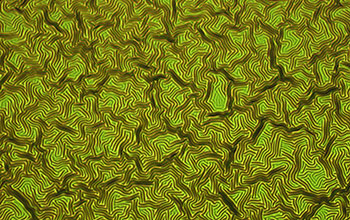Multimedia Gallery
"Chrome Labyrinth," by Michael Woodson
"Chrome Labyrinth," by Michael Woodson. Millions of tiny wrinkles formed when Woodson layered a sheet of chromium (0.1 micrometers thick) over a layer of acrylic polymer and heated the two together. "The formation of these patterns was totally accidental," says Woodson, "and actually caused a fair amount of trouble for me." The wrinkles tend to be parallel and spaced almost equally, and the distance between them varies -- higher temperatures make larger wrinkles that are spaced farther apart. The reason the wrinkles form is a mystery, says Woodson, but it could be because the different materials expand in different ways when heated, or because the way the chromium layer is deposited puts some stress on it. Woodson is a postdoctoral researcher in the Department of Chemistry in the College of Arts and Sciences at the University of North Carolina at Chapel Hill. Equipment: Motic PSM-1000 microscope.
More about this image
This image is from the second annual scientific art competition held by the Chapel Hill Analytical and Nanofabrication Laboratory (CHANL). CHANL is home to a series of electron microscopes; an X-ray photoelectron spectrometer; a cleanroom with photolithography, deposition and etching systems; and many other powerful imaging tools and equipment. The scientific art competition takes place in the spring and is open to anyone on campus. Entries this year came from students and faculty across the university, including many in pharmacy, biomedical engineering, medicine, computer science, studio art, physics and astronomy, and chemistry. Additional information on the competition and CHANL can be found on the CHANL website. (Date image taken: October 2009; date originally posted to NSF Multimedia Gallery: Sept. 14, 2017)
Credit: Michael Woodson, University of North Carolina
See other images like this on your iPhone or iPad download NSF Science Zone on the Apple App Store.
Images and other media in the National Science Foundation Multimedia Gallery are available for use in print and electronic material by NSF employees, members of the media, university staff, teachers and the general public. All media in the gallery are intended for personal, educational and nonprofit/non-commercial use only.
Images credited to the National Science Foundation, a federal agency, are in the public domain. The images were created by employees of the United States Government as part of their official duties or prepared by contractors as "works for hire" for NSF. You may freely use NSF-credited images and, at your discretion, credit NSF with a "Courtesy: National Science Foundation" notation.
Additional information about general usage can be found in Conditions.
Also Available:
Download the high-resolution JPG version of the image. (3.1 MB)
Use your mouse to right-click (Mac users may need to Ctrl-click) the link above and choose the option that will save the file or target to your computer.

